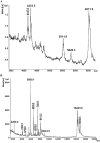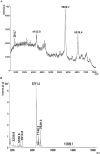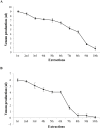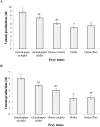Effect of Milking Method, Diet, and Temperature on Venom Production in Scorpions
- PMID: 30169760
- PMCID: PMC6121513
- DOI: 10.1093/jisesa/iey081
Effect of Milking Method, Diet, and Temperature on Venom Production in Scorpions
Abstract
In the present study, two common buthid scorpions, i.e., Androctonus finitimus (Pocock, 1897) (Scorpiones: Buthidae) and Hottentota tamulus (Fabricus, 1798) (Scorpiones: Buthidae), were maintained in the laboratory for venom recovery. The aim of study was to compare the quantity and quality of venom extracted from scorpions by manual and electrical method. We also recorded the effect of diet and temperature on venom production. Results of our study revealed that electrical method yielded good quality and higher quantity of venom as compared to manual method. The quantity of venom by two studied species differed statistically. We recorded the effect of food on venom production by providing different prey items to the scorpions and found that grasshopper nymphs and adults were the best diet for the scorpions to get maximum yield of venom as compared to other prey types (house crickets, house flies, and moths). Production of venom and activity of scorpions was found to be associated with temperature. During winter season, venom recovery was comparatively low as compared to the hottest part of year; when venom milking and activity of scorpions both were increased.
Figures











Similar articles
-
Environmental determinants of venom variability in captive scorpions: A comprehensive analysis of diet, temperature, and humidity effects.Toxicon. 2024 Nov 28;251:108151. doi: 10.1016/j.toxicon.2024.108151. Epub 2024 Oct 28. Toxicon. 2024. PMID: 39477096
-
Black scorpion (Heterometrus longimanus) as a laboratory animal: maintenance of a colony of scorpion for milking of venom for research, using a restraining device.Lab Anim. 1995 Oct;29(4):456-8. doi: 10.1258/002367795780740050. Lab Anim. 1995. PMID: 8558832
-
Assessing the effects of temperature, diet and threat conditions on defensive behaviour and venom regeneration in scorpion (Buthusatlantis).J Therm Biol. 2024 Aug;124:103966. doi: 10.1016/j.jtherbio.2024.103966. Epub 2024 Sep 1. J Therm Biol. 2024. PMID: 39270569
-
[Scorpion envenomation in Morocco: scorpions of the genus Androctonus, Buthus and Hottentota].Bull Soc Pathol Exot. 2014 Feb;107(1):39-47. doi: 10.1007/s13149-014-0332-7. Epub 2014 Jan 8. Bull Soc Pathol Exot. 2014. PMID: 24402964 Review. French.
-
[Reproduction biology and development of venom glands in scorpion Isometrus maculatus (DeGeer,1778) (Scorpiones: Buthidae)].Acta Trop. 1972;29(1):1-87. Acta Trop. 1972. PMID: 4400656 Review. German. No abstract available.
Cited by
-
Principal Component and Structural Element Analysis Provide Insights into the Evolutionary Divergence of Conotoxins.Biology (Basel). 2022 Dec 22;12(1):20. doi: 10.3390/biology12010020. Biology (Basel). 2022. PMID: 36671713 Free PMC article.
-
Armed stem to stinger: a review of the ecological roles of scorpion weapons.J Venom Anim Toxins Incl Trop Dis. 2021 Sep 3;27:e20210002. doi: 10.1590/1678-9199-JVATITD-2021-0002. eCollection 2021. J Venom Anim Toxins Incl Trop Dis. 2021. PMID: 34527038 Free PMC article. Review.
-
Impact of Temperature on the Immune Interaction between a Parasitoid Wasp and Drosophila Host Species.Insects. 2021 Jul 15;12(7):647. doi: 10.3390/insects12070647. Insects. 2021. PMID: 34357307 Free PMC article.
-
Proteotranscriptomic Insights into the Venom Composition of the Wolf Spider Lycosa tarantula.Toxins (Basel). 2020 Aug 5;12(8):501. doi: 10.3390/toxins12080501. Toxins (Basel). 2020. PMID: 32764230 Free PMC article.
-
Study of the Acute Toxicity of Scorpion Leiurus macroctenus Venom in Rats.ScientificWorldJournal. 2024 Jul 17;2024:9746092. doi: 10.1155/2024/9746092. eCollection 2024. ScientificWorldJournal. 2024. PMID: 39050385 Free PMC article.
References
-
- Ahsan M. M., and Tahir H. M.. 2016. Foraging behaviour of Hottentotta tumulus (Fabricius, 1798) and Odontobuthus odonturus (Pocock, 1897). Pakistan J. Zoo. 48: 1811–1815.
-
- Al Asmari A. K., H. A. Khan R. A. Manthiri K. M. Al Yahya, and Al Otaibi K. E.. 2014. Effects of Echis pyramidum snake venom on hepatic and renal antioxidant enzymes and lipid peroxidation in rats. J. Biochem. Mol. Toxicol. 28: 407–412. - PubMed
-
- Almaaytah A. and Albalas Q.. 2014. Scorpion venom peptides with no disulfide bridges: a review. Peptides. 51: 35–45. - PubMed
-
- Andreotti N., Jouirou B., Mouhat S., Mouhat L., and Sabatier J. M.. 2010. Therapeutic value of peptides from animal venoms, pp. 287–303. In H. W. Liu, and L. Mander (eds.), Amino acids, peptides and proteins, comprehensive natural products II: chemistry and biology. Elsevier, Oxford.
Publication types
MeSH terms
Substances
LinkOut - more resources
Full Text Sources
Other Literature Sources

